Talinn Grigor researches history written in stone
Brandeis University Magazine explores Iranian art and architecture
 |
|
Download the spring |
The following article, by Deborah Halber ’80, appears in the spring 2010 issue of Brandeis University Magazine. Visit the magazine's website to see what else is inside.
Iran—known throughout much of history as Persia—is a nation of paradox, shaped by secularism and religion, the East and the West, the ancient and the modern. To architectural historian Talinn Grigor, Iran’s buildings embody the country’s conflicting influences.
Grigor, who joined the Brandeis faculty in 2008 as assistant professor of modern and contemporary architecture in the Department of Fine Arts, explores the relationship of political power struggles and Iranian art and architecture.
“All my work so far centers around the relationship between architecture and the state by giving voice to a history that has not been fully written,” she says.
Grigor elucidates aspects of that history in two forthcoming books: "Of Kitsch, Censorship, and Exile: Contemporary Iranian Visual Arts," which deals with the politics of contemporary Iranian art inside and outside Iran; and "Persian Architecture and Kingship: Displays of Power and Politics in Iran from the Achaemenids to the Pahlavis" (coedited with Sussan Babaie).
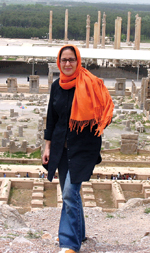 |
| Talinn Grigor |
The idea that architecture can reflect political agendas might be unfamiliar to Americans, whose iconic buildings don’t tend to be rebuilt or reconceived when a new administration is sworn in. But Iran’s tumultuous past has turned, for instance, a modernistic prayer house into a storage shed and an athletic complex into a religious destination. Mausoleums erected to honor an epic poet and an ancient philosopher-scientist are now imprinted with postrevolutionary language and symbols. These structures were not torn down but reinvented, Grigor notes.
“They were made by the patrons, used by the people, and then reedited by the Islamic Republic,” she says. Invested with a layer of meaning never envisioned by their creators, the buildings became living monuments to the histories of their times, cultural symbols of the dilemmas the Islamic Republic of Iran faces in reconciling Iranian nationalism with Shi’a theology.
The Pahlavi dynasty ruled from 1925 to 1979. In 1971, the last shah held a three-day event next to the ruins of Persepolis, the ceremonial capital of the Persian Empire during the Achaemenid dynasty. In honor of the 2,500th anniversary of the founding of the empire by Cyrus the Great, the shah invited monarchs and heads of state to what has been described as the most lavish party of the twentieth century. Grigor says the event was yet another instance of an architectural structure being co-opted for political ends. She and other historians have noted that it marked the beginning of an anti-shah and anti-West movement that culminated eight years later in the Iranian Revolution.
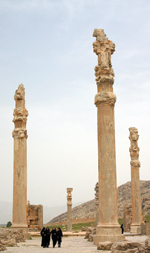 |
| persepolis today |
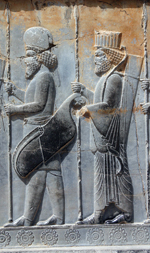 |
|
depiction of ancient |
Grigor is a realist about the political turmoil that continues to envelop Iran. Many of Iran’s print and broadcast media outlets are state-run. Satellite dishes are banned, although many find ways to watch foreign TV and surf the Web. Last June, the ultraconservative Mahmoud Ahmadinejad was reelected as Iran’s president in a bitterly contested race, leading to the most serious internal unrest since the 1979 Islamic Revolution.
Since the revolution, Grigor says, “So many scholars cannot go to Iran.” Her particular passion—the architecture of the mid-nineteenth century to the early twentieth century in Iran and India—is removed in time, therefore less politically charged than some studies. For half a century, royal residences were built under the Qajar monarchy in an eclectic style that included Western and Islamic architectural traditions, pre-Islamic Iranian traditions, and contemporary images.
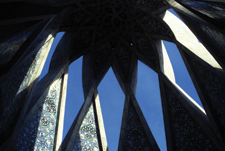 |
| detail from mausoleum of omar khayyam in neshapur |
Meanwhile, they borrowed architectural elements—some serious, some frivolous, some accidental—from around the world. These elite Parsis, the larger of the two Indian Zoroastrian communities, saw themselves as “entirely Indian and entirely British and entirely Persian.” They were multicultural before the term was fashionable, Grigor says.
The professor knows what it’s like to embody multiple identities. She cloaks her own past in a bit of mystery, skirting questions about where she’s from by saying only that she grew up on three continents and speaks four languages, none without an accent. Grigor’s office doesn’t give away much. Its only decorations are a Soviet propaganda poster of a youth wielding a red flag and a wooden architectural model of her final project at the University of Southern California (USC) School of Architecture.
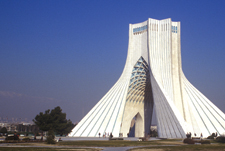 |
| azadi tower in tehran includes elements of sassanian and islamic architecture |
“I am at home in multiple cultures, but also an outsider. For the longest time, I thought this was something horrible,” she says. Now she feels having multiple perspectives might be better than one certain perspective. Knowing many languages, knowing many cultures, is a privilege.
“I also feel very American. I’m an American scholar through and through,” she says. Grigor would like her children, now ages one and three, to experience the world as their backyard. When they’re older and learning about capitals, for instance, she imagines whisking them off to Paris. She tries to instill in her children and in her students a sense of belonging to an enormously diverse world. “We all belong to six billion other people,” she says. “We are very privileged to be part of something bigger.”
In Iran, you only have to look at the architecture to know that’s true.





